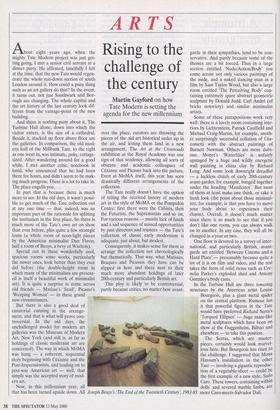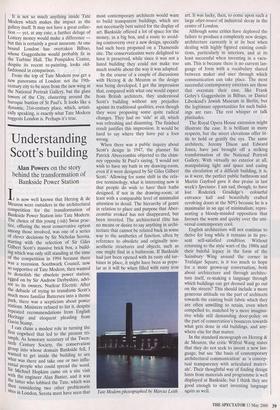Rising to the challenge of the century
Martin Gayford on how Tate Modern is setting the agenda for the new millennium
About eight years ago, when the mighty Tate Modern project was just get- ting going, I met a senior civil servant at a dinner party. He affirmed, fancifully I felt at the time, that the new Tate would regen- erate the whole run-down section of south London around it. How could a puny thing such as an art gallery do that? In the event, it turns out, not just Southwark and Bor- ough are changing. The whole capital and the art history of the last century look dif- ferent from the vantage-point of the new building.
And there is nothing puny about it. The Turbine Hall alone, down into which the visitor enters, is the size of a cathedral. Beside it, stacked up floor above floor are the galleries. In comparison, the old mod- ern half of the Millbank Tate, to the right as one went in, was intimate, poky, cottage- sized. After wandering around for a good while, I met another critic, notebook in hand, who announced that he had been there for hours, and didn't seem to be mak- ing much progress. There is a lot to take in. The place engulfs you.
In part that is because there is much more to see. In the old days, it wasn't possi- ble to get much of the Tate collection out at any one time — that, indeed, was an important part of the rationale for splitting the institution in the first place. So there is much more of the Tate's own art on show than ever before, plus quite a few strategic loans (a whole room of neon-light pieces by the American minimalist Dan Flavin, half a room of Beuys, a bevy of Warhols).
Spread out in these wonderfully cool, spacious rooms some works, particularly the newer ones, look better than they ever did before (the double-height room in which many of the minimalists are present- ed is itself a beautiful work of minimalist art). It is quite a surprise to come across old friends — Matisse's 'Snail', Picasso's `Weeping Woman' — in these grand new circumstances.
But there is also a good deal of curatorial cunning in the arrange- ment, and that is what will prove con- troversial. In the old days, the unchallenged model for modern art galleries was the Museum of Modern Art, New York (and still is, as far as holdings of classic modernist art are concerned). The way in which MoMA was hung — a coherent, sequential story beginning with Cezanne and the Post-Impressionists, and leading on to post-war American art — well, that simply was the accepted story of mod- ern art.
Now, in this millennium year, all that has been turned upside down. All over the place, curators are throwing the pieces of the old art historical order up in the air, and letting them land in a new arrangement. The Art at the Crossroads exhibition at the Royal Academy was one sign of that tendency, allowing all sorts of obscure and academic colleagues of Cezanne and Picasso back into the picture. Even at MoMA itself, this year has seen drastically different arrangements of the collection.
The Tate really doesn't have the option of telling the received history of modern art in the style of MoMA or the Pompidou Centre: first there were the Cubists, then the Futurists, the Suprematists and so on. For various reasons — mainly lack of funds and a sad sequence of missed opportunities by past directors and trustees — the Tate's collection of classic early modernism is adequate, just about, but modest.
Consequently, it makes sense for them to arrange the collection not chronologically but thematically. That way, what Matisses, Braques and Picassos they have can be slipped in here and there next to their much more abundant holdings of later 20th-century and particularly British art.
This ploy is likely to be controversial, partly because critics, no matter how avant- Joseph Beuys's The End of the Twentieth Century', 19 garde in their sympathies, tend to be con- servative. And partly because some of the themes are a bit forced. Thus in a large section entitled `Nude/Action/Body' you come across not only various paintings of the nude, and a naked dancing man in a film by Sam Taylor-Wood, but also a large room entitled 'The Perceiving Body' con- taining extremely spare abstract geometric sculpture by Donald Judd, Carl Andre (of bricks notoriety) and similar minimalist artists.
Some of these juxtapositions work very well: there is a lovely room containing inte- riors by Lichtenstein, Patrick Caulfield and Michael Craig-Martin, for example, anoth- er surprisingly successful collation of Gia- cometti with the abstract paintings of Barnett Newman. Others are more dubi- ous: Monet's 'Waterlilies' is unfairly upstaged by a huge and wildly energetic wall painting in china clay by Richard Long. And some look downright dreadful — a luckless clutch of early 20th-century avant-gardes, for example, bunged together under the heading 'Manifestos'. But most of them at least make one think, or take a fresh look (the point about those minimal- ists, for example, is that you have to move your body about to experience their charm). Overall, it doesn't much matter since there is so much to see that if you don't like one room, you can always walk on to another. In any case, they will all be changed in a year or two.
One floor is devoted to a survey of inter- national, and particularly British, avant- garde art entitled 'Between Cinema and a Hard Place' — presumably because quite a lot of it is on film and video, and the rest takes the form of solid items such as Cor- nelia Parker's exploded shed and Antony Gormley's body casts.
In the Turbine Hall are three towering structures by the American artist Louise Bourgeois, plus a giant metal spider on the central platform. Rumour has it that powerful figures in the Tate would have preferred Richard Serra's `Torqued Ellipses' — huge maze-like metal sculptures which have been on show at the Guggenheim, Bilbao and elsewhere — to take this position.
The Serras, which are master- pieces, certainly would look marvel- lous here. But Bourgeois has risen to the challenge. I suggested that Mona Hatoum's installation in the other Tate — involving a gigantic reproduc- tion of a vegetable-slicer — could be the first example of a new style, Sado Caro. These towers, containing within dolls' and severed marble limbs, are 83-85 more Caro-meets-Salvador Dali. It is not so much anything inside Tate Modern which makes the impact as the gallery itself. It may not have a great collec- tion — yet, at any rate; a further deluge of Lottery money would make a difference but this is certainly a great museum. At one bound London has overtaken Bilbao, whose Guggenheim would probably fit in the Turbine Hall. The Pompidou Centre, despite its recent re-painting, looks old- fashioned in comparison.
From the top of Tate Modern you get a new panorama of London: not the 19th- century city to be seen from the new wing at the National Portrait Gallery, but the glass towers of the City, clustering around the baroque bastion of St Paul's. It looks like a dynamic, 21st-century place, which, artisti- cally speaking, is exactly what Tate Modern suggests London is. Perhaps it's true.



























































 Previous page
Previous page